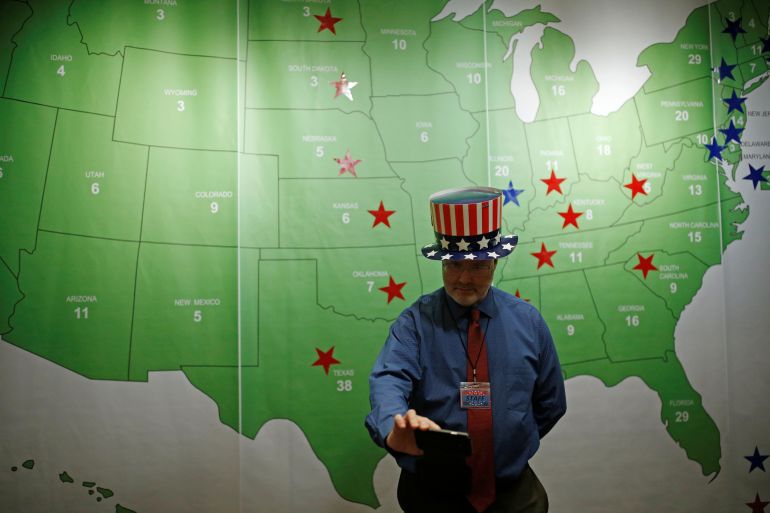US election: What time are election results?
Millions of Americans are voting, but when exactly will we know whether Trump or Biden won the election?

Polls begin closing in the United States at 18:00 Eastern Standard Time (23:00 GMT) and poll closing times vary by state. Results in each state will not begin coming in until polls close in each particular state.
Projections of winners will not be made until all of the polls close in a state. The first projections of states that Donald Trump and Joe Biden have won will not begin until 19:00 EST (00:00 GMT), when all of the polls have closed in nine states.
Keep reading
list of 4 itemsTrump ally Rudy Giuliani files for bankruptcy following defamation case
‘Insurrection’ should bar Donald Trump from US presidency, lawyers argue
Ex-Proud Boys leader Joseph Biggs sentenced to 17 years for US Capitol riot
When will we know who will be called as America’s next president?
The earliest we could know whether a presidential candidate is projected to have won 270 electoral votes, the number of electoral votes needed for victory, is likely to be 23:00 EST (04:00 GMT). That is when polls close in California, which has the most electoral votes of any state – 55 – and that could put a candidate over the 270 threshold.
However, 23:00 EST is considered early, at least in recent history. Of the past five presidential elections, only 2008 was called at that time, when California’s projected win for Barack Obama put him past the 270 electoral vote threshold. In 2012 and 2016, the winners were projected in the overnight EST hours.
Twice in the past five elections, projections of winners were not even made on election night. In 2004, George W Bush was not called the winner until midday the day after the election.
And in 2000, the media outlets making projections erroneously called Florida for Al Gore before rescinding that projection. The close nature of the results of that race led to neither Gore nor George W Bush having enough electoral votes without Florida’s results, leading to weeks of recounts and legal battles. Florida was not called until December 12, when the US Supreme Court ordered the state’s recount halted. Bush had a 537-vote lead at that point and was declared the winner, delivering him the state’s electoral votes and an Electoral College victory.
Why does it take so long to project a winner?
It is worth noting that the process of “calling” winners and losers in each state is not necessarily based on exact vote tallies but is based on projections made by analysts who look at polling and how vote counts are shaping up in key precincts or counties.
If it is a state where one candidate is expected to win from the get-go – and potentially 30 states fall into that category this year – then those states can be projected as soon as polls close or shortly thereafter.
If it is a closely-contested state or it is not obvious who the winner is at a state’s poll closing time, then projections of winners will be delayed as analysts watch the vote tallies come in. The closer the count – or any vote-counting problems – can slow down the timing of a projection.
So, who is making these projections?
The US media. US media outlets have a long history of trying to speed up the process of informing Americans of the winners and losers of presidential races, and it has not always run smoothly.
In addition to the 2000 election projection problem, there were some other infamous incorrect projections. In 1916, the New York Times prematurely and erroneously declared Charles Evans Hughes the winner over Woodrow Wilson. In 1948, election analysts at the Chicago Daily Tribune famously – and incorrectly – concluded that Thomas Dewey defeated Harry Truman.

The system that is used for election projections today has its roots in the early 1960s, when the major US wire services and television networks pooled their resources to place thousands of people all over the country to gather precinct returns, which were fed into computers to help make calls. In 1990, the Associated Press and US broadcasters created a new system that combined exit polling with vote results, which is generally the method still in use today.
Currently, the Associated Press and Fox News share one set of exit polls and come up with their own separate projections. ABC, CBS, CNN and NBC are the remaining members of the system that was formed in 1990, and they use that data to reach their own projections.
Is the result official?
No. Counting every single vote will take several days and, in some cases, several weeks. States have different methods and procedures for counting in-person and mail-in ballots and when their counts are completed, each state will certify its results. If all goes as planned, each state’s certified results will be formally presented when the state meets to certify its electors, prior to the Electoral College meeting on December 14.
The vote count has never been certified on election night and 2020 is no different. What potentially complicates things this year is that most states will be counting more mail-in ballots than ever, and their procedures have not been tested at this scale. It is expected there will be vote-counting issues in some states. Three states – all tightly contested – Pennsylvania, Michigan and Wisconsin are not allowed to begin counting mail-in votes until November 3, which could prolong an announcement.
If neither candidate has been projected as the Electoral College winner and projections for some states are on hold because there is a wait for a vote count, that could create long delays in knowing who the winner will be.
And that scenario has some worried about potential political mischief and protracted legal battles, prolonging the declaration of a final outcome.
